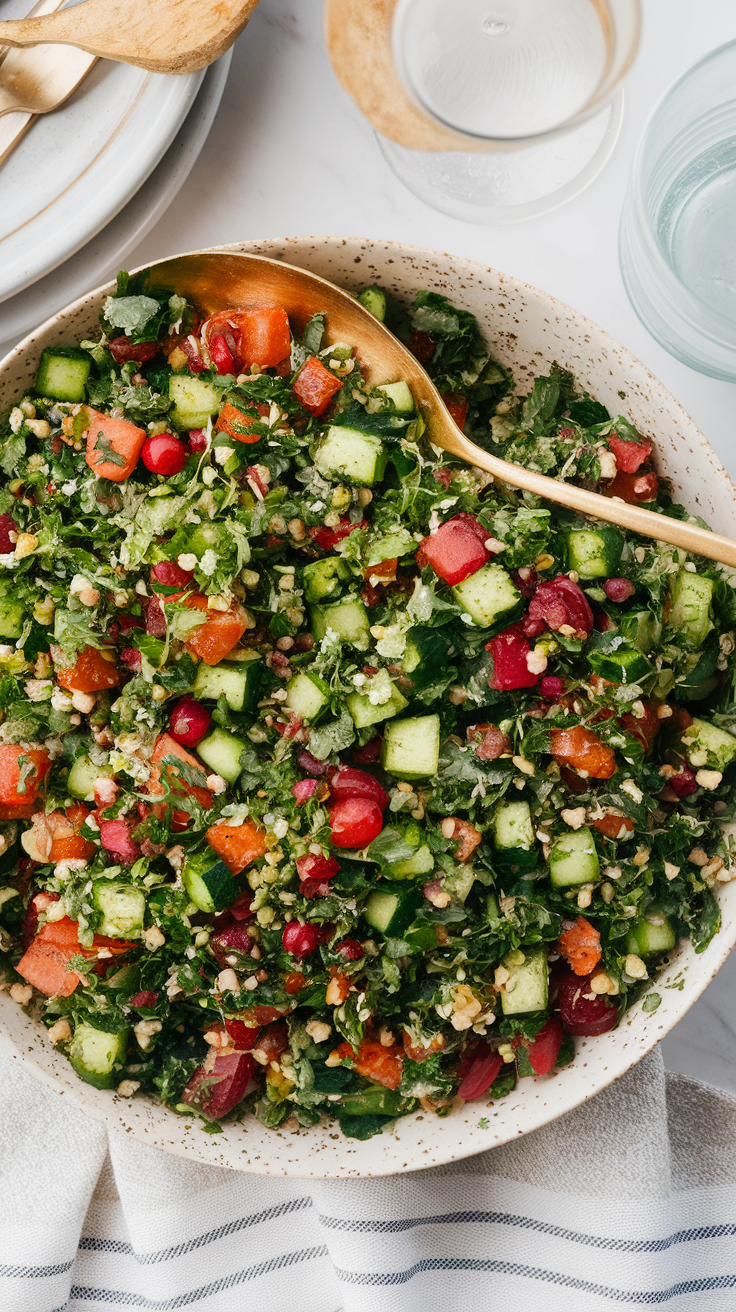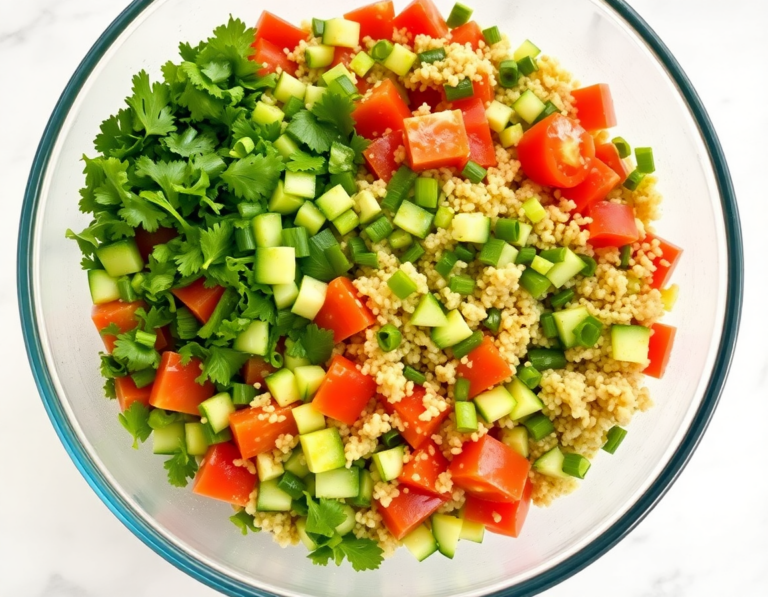You know, sometimes I find myself dreaming of sun-drenched Mediterranean landscapes—those lazy afternoons where time seems to slow, and flavors dance like shadows across a sunlit terrace. That’s exactly where this Tabbouleh Salad takes me every time. Brimming with fresh parsley, juicy tomatoes, and a zing of lemon, it’s like capturing a summer breeze on your fork.
Steps
- Chop fresh parsley and mint using a sharp knife to avoid bruising the herbs and maintain their light texture.
- Prepare the bulgur: for coarse bulgur, boil 2 cups of water, add 1 cup bulgur, cover, and let it sit off the heat for 20-30 minutes until tender. For fine bulgur, soak in 1/2 inch of water for 20 minutes. Drain any excess water and fluff with a fork. Allow it to cool to room temperature.
- In a large bowl, whisk together olive oil, lemon juice, minced garlic, salt, coriander, and cinnamon to create the dressing.
- Add chopped parsley, mint, diced cucumber, tomatoes, cooked bulgur, and sliced scallions to the bowl with the dressing. Toss everything together until well combined.
- Taste the salad and adjust the seasoning if necessary. Serve immediately or chill in the refrigerator for up to 3 days to let the flavors meld.
Ingredients
- 1 bunch curly parsley, finely chopped
- 1/2 cup fresh mint leaves, finely chopped
- 2/3 cup cooked coarse bulgur wheat (or fine bulgur, prepared as described)
- 1 English or Persian cucumber, diced (or 1 regular cucumber, peeled and seeded)
- 2 large tomatoes, diced
- 4 scallions, thinly sliced
- 2 cloves garlic, minced
- 1/2 teaspoon ground coriander
- 1/4 teaspoon ground cinnamon
- 1/4 cup fresh lemon juice
- 1/4 cup extra-virgin olive oil
- Sea salt, to taste
FAQ
- What is traditional tabbouleh made of?
- Traditional tabbouleh is a Middle Eastern salad primarily composed of finely chopped parsley and mint, accompanied by tomatoes and bulgur wheat. The herbs are the star of the dish, providing a pungent and refreshing flavor.
- Can I use a food processor to chop the herbs for tabbouleh?
- It is recommended to chop the herbs by hand with a sharp knife. Using a food processor can bruise the herbs, resulting in a soggy texture rather than the desired light and fresh one.
- How do you prepare bulgur wheat for tabbouleh?
- For coarse bulgur, boil 2 cups of water, add 1 cup of bulgur, cover, and let it sit off the heat for 20 to 30 minutes until tender. Drain any excess water and fluff with a fork. Fine bulgur can be soaked in water for 20 minutes. Ensure it’s drained and cooled to room temperature before adding to the salad.
- How long can tabbouleh be stored?
- Tabbouleh can be prepared and stored in the refrigerator for up to 3 days. The flavors continue to develop and intensify as it sits, making it even more delicious over time.
- What are some serving suggestions for tabbouleh?
- Tabbouleh pairs well with Mediterranean and Middle Eastern dishes. It can be served alongside falafel wraps, mezze platters with dips like hummus and baba ganoush, or as a refreshing side dish to various meals.
Tips
- Use a Sharp Knife for Herbs: When chopping the herbs, such as parsley and mint, opt for a sharp knife instead of a food processor to prevent bruising and maintain a light texture in the salad.
- Choose the Right Bulgur: If you can’t find fine bulgur, coarse bulgur is a suitable alternative. Both types work well, but ensure to prepare and cool them properly before adding to the salad.
- Mix and Chill: After combining the ingredients, allow the salad to chill in the refrigerator for up to three days. This resting time enhances the flavors as they meld together.
- Serve with Complementary Dishes: Pair your tabbouleh with Mediterranean and Middle Eastern dishes, such as falafel wraps, hummus, or pita bread, to create a delightful mezze platter.
Equipment
- Fine or Coarse Bulgur Wheat – If not readily available at local stores, you might need to order this online.
- Large Mixing Bowl – For preparing and tossing the salad ingredients.
- Whisk – For mixing the dressing.
- Sharp Chef’s Knife – Essential for finely chopping herbs and vegetables.
- Cutting Board – A sturdy surface for chopping ingredients.
- Medium Pot with Lid – Needed for cooking coarse bulgur if it’s not pre-cooked.
- Fine Mesh Sieve – Useful for draining excess water from the bulgur.

